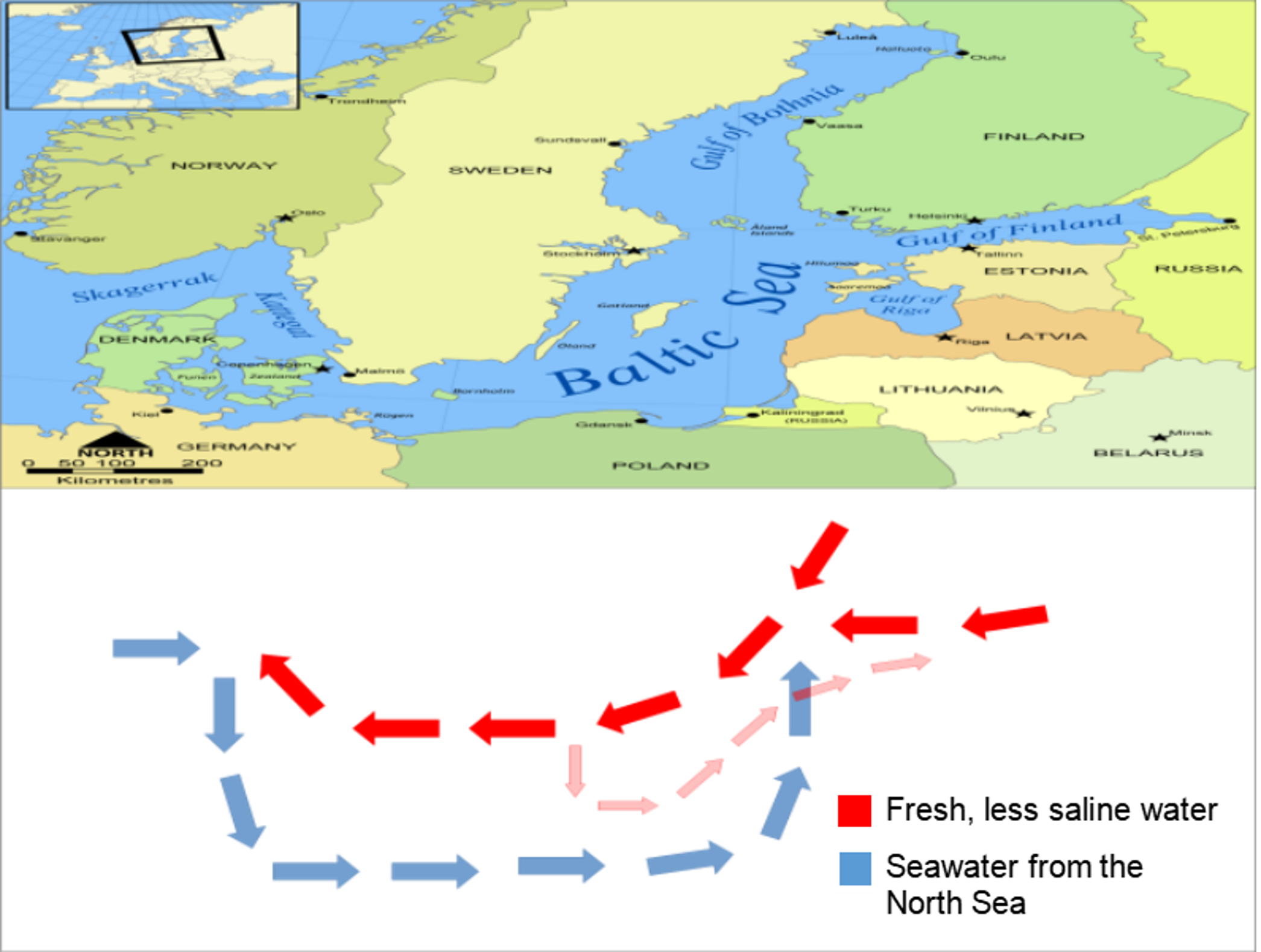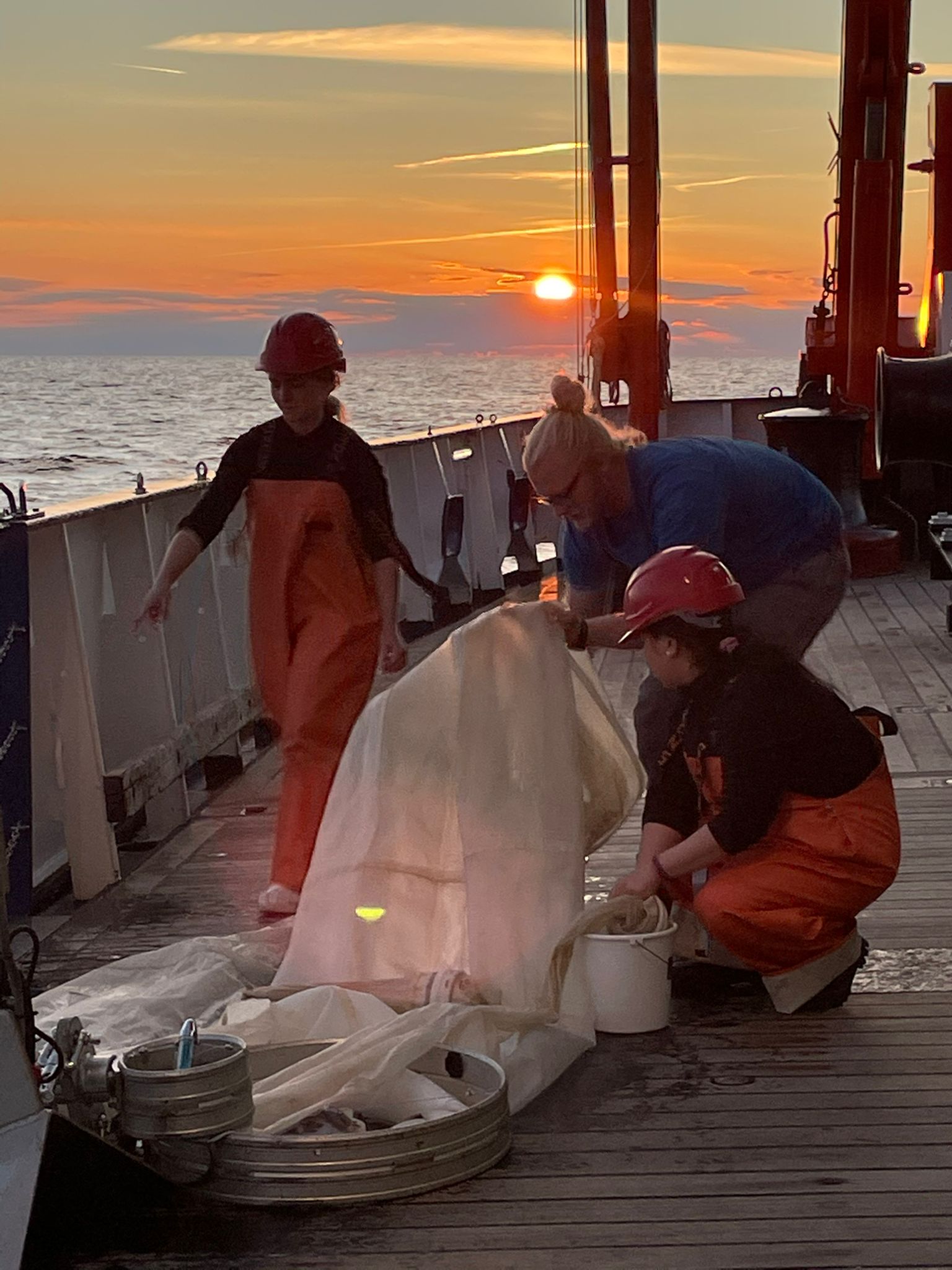It was a nice and sunny day, like most of our days on the Alkor, the research vessel of our cruise. Steady noise coming from the winch and anticipating buzz, which surrounded a group of students with safety boots and helmets, filled the air. Once the upcoming net broke the water surface and got „gehievt“ on board, the hectic movements on deck eerily resembled a swarm of bees circling a hive. Or maybe the image of a group of beekeepers eager for the honey inside the hive would be more fitting? Anyways, the „honey“ ended up in the jar and everything was set up for the next „harvest season“.
This is what our work on the Alkor looked like most of the time. To not get lost in this analogy of sandwich spreads, let‘s lay everything open: Our „honey jars“ were our samples. We, the beekeepers and students of this Alkor cruise, took samples at a lot of stations in the Baltic Sea, from Kiel Bight to the Gotland Basin, to study plankton composition and the abundance of fish larvae and jellyfish. We also measured the water temperature, salinity and depth. Depending on the task, we used different equipment for one or the other.
With the multi net, for example, we could collect separate samples at different depths in one haul. When we compared the resulting samples per water depth, we found pronounced differences even at the same station. The plankton composition, but also abundance of fish larvae and jellyfish varied drastically, between depths as well as between parts of the Baltic Sea. Why is that?
Let‘s try to imagine the ocean as a big office building. On each floor, there are employees working on different things. Some floors might work on very similar topics, but the dynamic between coworkers is unique. In this case, phytoplankton, which uses sunlight for energy production, would mostly occupy the top floors, as it is dependent from light for photosynthesis. Zooplankton, which grazes on the former and needs organic materials as food, would follow. At the lower levels, there would be more and more microorganisms focusing on degrading sinking biomass like dead plankton cells. This transport of biomass from the surface to deeper water layers is, again, quite similar to an office building, where some employees go from floor to floor, which connects the whole system.
Back on deck, it was also very apparent that the samples of the upper water column contained significantly more biomass compared to the ones from the bottom water. This is in line with what we would expect during a phytoplankton bloom. Nevertheless, there is another reason why we hardly found anything alive in the samples from about below 60 m. The topic surrounding this has become more urgent in the Baltic Sea over the years: Oxygen minimum zones.
If we stay with architecture for a moment, the open ocean resembles a building with a well-designed ventilation system. The air at underground levels might not be as „fresh“ as upstairs in a room with open windows, but the air supply is still sufficient.

The bottom water in the Baltic Sea, on the other hand, becomes increasingly similar to an old basement. The air is old and stale, as the door only gets opened every now and then and nobody wants to go down, let alone live there. This is where the brackish nature of the Baltic Sea comes into play. Fresh water from rain and rivers does not mix well with the salty water from the North Sea. The incoming saltwater is heavier, which is why it spreads at the bottom of the Baltic from the west towards the east. There is only slow mixing between the water masses.
And how exactly is that related to oxygen minimum zones? Well, the degradation of biomass, such as plankton cells, consumes oxygen. After a huge phytoplankton bloom has died of and sunken to the deep, this biomass might lead to almost complete oxygen depletion near the bottom of the water column. Mixing would usually help these areas to recover but the strong stratification of the Baltic Sea hampers mixing processes. Nutrient pollution of the Baltic from fertilizers and the like has only increased this effect and the spread of these oxygen minimum zones over the past decades. Only adapted species can live here for longer periods of time. So, our nets from the bottom were almost empty.
By reading all this, you might have already got the sense that its unique properties make the Baltic Sea extremely interesting for scientific research. The especially strong anthropogenic influences from fishery and pollution open the possibility to develop models and predictions, what similar seas might look like in the future. Yes, the Baltic Sea is „the sea next door“. But this makes our cruise on the Alkor all the more special to us.
Now, beekeepers, the next flower is coming on deck, let‘s get some more honey!
Philipp Weyand

Hello Mr. Weyand,
Thank you for your very interesting article!
I was thinking that if the North Sea is primarily circulating at the lowest levels (since the upper level is fed by freshwater runoff which does not mix well), why doesn’t the North Sea circulation do a better job of “flushing out the lower level? I am guessing it’s just a function of speed and volume, and at least one of these must be very slow or small.
And, if I may posit as second question, is there any unified effort to monitor, regulate, and/or curtail pollution from flowing into the Baltic Sea? In looking at your map within the context of your reporting the low level of seawater circulation and the well known diversity of people surrounding the Baltic Sea, I can’t help but be concerned that a collective effort is making any progress.
I would enjoy hearing any thoughts or insights you may have on either/both of these questions. Thanks.